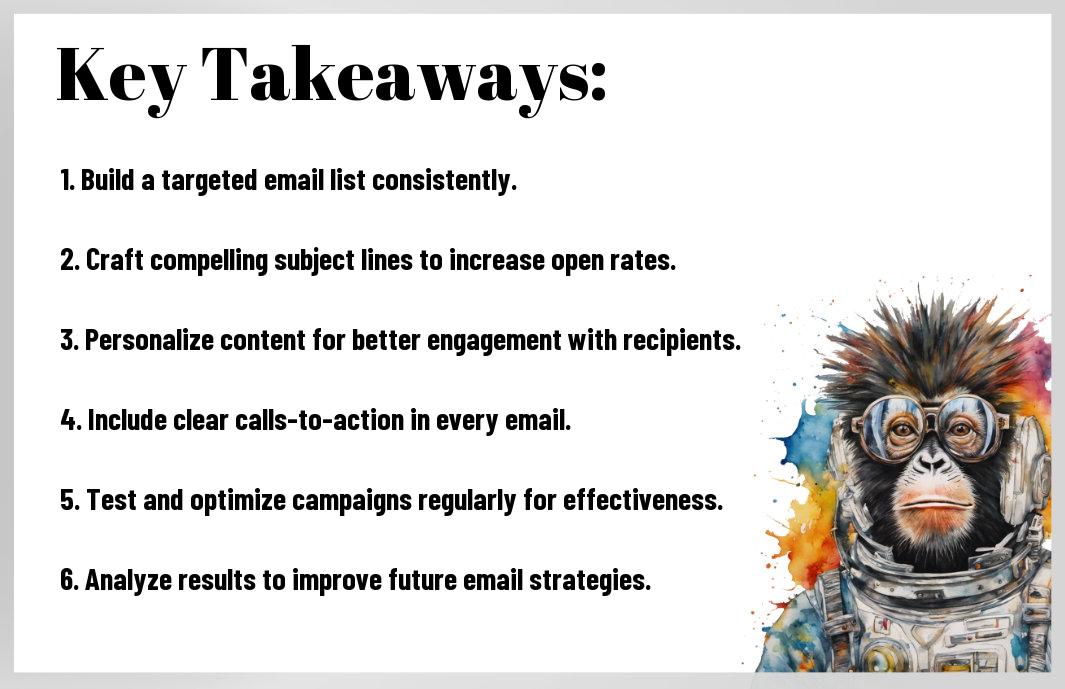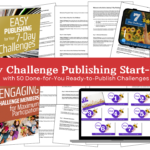Affiliate marketing can be a highly effective way to generate income, and email marketing plays a pivotal role in this strategy. In this post, I will share best practices that can help you maximize your affiliate promotions through email. You’ll learn the importance of building a targeted email list, creating engaging content, and maintaining consistent communication with your audience. By following these tips, you can increase your chances of driving conversions and nurturing a loyal customer base, all while avoiding common pitfalls.


Understanding Affiliate Marketing
Before entering into the best practices for email marketing in affiliate promotion, it’s necessary to grasp the concept of affiliate marketing itself. Affiliate marketing is a performance-based marketing strategy where businesses reward individuals (or affiliates) for driving traffic or sales to their products or services through their marketing efforts. This practice enables companies to extend their reach while providing affiliates an opportunity to monetize their online presence. If you’re looking to enhance your understanding, I recommend checking out Affiliate Email Marketing: Top Strategies & Programs for 2024 for comprehensive insights.
Definition and Overview
Across different industries, the affiliate marketing model has gained immense popularity due to its low-risk nature and potential for significant returns. When I explore this domain, I find that affiliates promote products or services via various channels, such as websites, social media, or email marketing, earning a commission based on the sales they generate or leads they create. This arrangement often leads to a win-win scenario, where businesses increase their visibility and sales, while affiliates earn money from every successful transaction.
Key Players in Affiliate Marketing
Before you can effectively engage in affiliate marketing, it’s important to understand the major players involved in this ecosystem. The primary entities include the merchant (or seller), the affiliate (or publisher), the consumer, and the affiliate network or program that connects these parties. Each player’s role is significant, as the merchant supplies the products, the affiliate promotes them, the consumer makes the purchase, and the network facilitates the transactions and tracks performance.
Plus, a successful affiliate marketing campaign hinges on collaboration and clear communication among all key players. The merchant must provide affiliates with the right tools and resources for effective promotion, while the affiliate must align their marketing strategies with the merchant’s goals. It’s necessary to maintain a strong relationship with your audience, understanding their needs and preferences, to ensure that your promotional efforts translate into successful conversions. On the flip side, poorly managed relationships can lead to conflicts and negative impressions—resulting in lost revenue and partnership opportunities. By engaging with and supporting each affiliate, I’ve observed that companies can cultivate lasting partnerships that benefit everyone involved.
Crafting Effective Email Campaigns
Any successful email campaign begins with a well-thought-out strategy that resonates with your audience. I believe that understanding your target demographic and their preferences can significantly improve your email marketing performance. From compelling content to eye-catching visuals, every element of your email should work together to engage your subscribers and encourage them to take action. By analyzing your campaign metrics, you can continuously refine your approach, ensuring you stay relevant in the fast-paced digital world of affiliate promotion.
Subject Lines that Grab Attention
An effective subject line is your first opportunity to make an impression. It’s not just about getting your email opened; it’s about setting the tone for what’s inside. I often test various approaches—whether it’s using humor, urgency, or personalization—to see what resonates most with my audience. A/B testing can help you identify which subject lines yield the highest open rates, thus enhancing the overall effectiveness of your campaigns.
Personalization and Segmentation Strategies
For me, personalization and segmentation are key ingredients in crafting impactful email campaigns. By segmenting my email list based on factors like past purchases, engagement rates, or demographics, I can tailor my messages to the specific interests and needs of different subscriber groups. This practice not only increases engagement but also fosters a sense of connection with my audience, making them feel valued as individuals rather than just another statistic on a list.
Plus, utilizing personalized greetings, custom content, and special offers based on your users’ preferences can drive higher conversion rates. You can even leverage technologies and data analytics to understand your audience better, which allows you to send highly targeted messages that resonate deeply with their interests. When you personalize your emails and segment your audience effectively, you create a more engaging experience for your subscribers, leading to increased loyalty and profitability in your affiliate promotions.

Content Creation for Email Marketing
Unlike traditional marketing methods, email marketing offers a unique platform for directly engaging with your target audience. With carefully crafted content, you can create a meaningful connection and enhance your affiliate promotion efforts. To achieve this, it’s crucial to provide content that resonates with your subscribers while maintaining the integrity of your brand. I’ve found that a good balance of informative, entertaining, and promotional content keeps readers invested and eager for more updates.
In the matter of crafting your emails, I focus on making the content relatable and engaging. This not only encourages high open rates but also drives conversions through your affiliate links. Leveraging persuasive storytelling techniques can really elevate your content and make it stick in the minds of your audience. They are not just looking for a sales pitch; they want value and insights that enrich their lives.
Value-Driven Content
Email marketing thrives on the notion of value. I’ve seen firsthand that providing informative resources, tips, and insights builds trust between you and your subscribers. Whenever I create an email, I ask myself: “What can I offer my audience that will genuinely help them?” By answering this question, I focus on delivering quality content that addresses their needs and interests. Techniques like how-to guides, exclusive insights, or even expert interviews can turn your emails into a valuable resource that your audience looks forward to opening.
This not only enhances your credibility but also positions you as an authority in your niche. When your content consistently delivers value, your audience is more likely to engage with your affiliate promotions. They start to view you as a trusted source, which can significantly boost your conversion rates.
Incorporating Affiliate Links Effectively
Behind every successful email marketing campaign is a well-thought-out strategy for incorporating affiliate links. I’ve learned that the placement and context of these links can make a substantial difference in your click-through rates. It’s vital to introduce affiliate links in a way that feels organic and relevant to your readers’ interests. Don’t just throw links in haphazardly; instead, consider using persuasive language that highlights the benefits of the product or service you’re promoting.
Plus, it’s important to track which links perform the best so you can optimize your strategy over time. By analyzing data on which emails and links see the highest engagement, I adjust my content strategically. You want to avoid overwhelming your subscribers with too many links or promotional messages. Instead, focus on quality over quantity and always provide context on why your recommendations matter. This method not only maintains the integrity of your content but also establishes trust, ultimately driving higher conversions for your affiliate promotions.
Compliance and Best Practices
Understanding GDPR and CAN-SPAM Laws
Any effective email marketing strategy must take into account the legal frameworks that govern communication. The General Data Protection Regulation (GDPR) and the CAN-SPAM Act are fundamental in ensuring that your email practices are compliant. GDPR mandates that individuals must give explicit consent before receiving promotional emails, and they have the right to easily withdraw that consent at any time. This law also emphasizes the need for clear and transparent data collection practices, which means you should inform your users why you are collecting their data and how it will be used. On the other hand, the CAN-SPAM Act requires you to provide a clear opt-out option in every email and to honor such requests promptly. Failure to comply can result in high fines and damage to your brand’s reputation.
Managing Subscriber Consent
Across the affiliate marketing landscape, managing subscriber consent is an crucial practice that ensures compliance with legal regulations and builds trust with your audience. I recommend implementing double opt-in practices, where subscribers confirm their email addresses to further verify their consent. Additionally, you should provide a clear description of what subscribers can expect to receive in terms of content and frequency of emails. This transparency fosters a sense of security and helps to improve your open and click-through rates.
Understanding the nuances of managing subscriber consent does not stop at the opt-in process. It’s important to make it easy for your subscribers to update their preferences or change their consent at any time. Providing a simple and visible unsubscribe link in your emails can alleviate any potential frustration, ensuring that your audience feels in control of their engagement with your brand. In this way, you not only comply with the regulations but also maintain a positive relationship with your subscribers, which is crucial for long-term success in affiliate promotion.
Measuring Success in Email Marketing
Once again, understanding how to measure success in email marketing is vital for determining the effectiveness of your affiliate promotions. Tracking performance metrics allows you to understand what resonates with your audience, ultimately leading to better conversion rates and increased revenue. You must consistently evaluate your campaigns to identify trends and make informed adjustments that will enhance your strategy over time.
Key Metrics to Monitor
Beside overall campaign performance, it’s crucial to focus on specific key metrics that indicate success in email marketing. You should keep an eye on open rates, which tell you how many recipients are engaging with your subject lines. Click-through rates (CTRs) also play a significant role; they measure how many people are taking action by clicking links in your emails. Additionally, monitoring conversion rates helps you gauge how effectively your newsletters drive sales, while unsubscribe rates can indicate if there’s an issue with the content or targeting of your emails.
Tools for Campaign Analysis
For effective campaign analysis, utilizing the right tools can significantly enhance your understanding of email performance. There are numerous platforms available, such as Mailchimp, Constant Contact, and HubSpot, which provide comprehensive reporting features to track the success of each campaign. These tools come with built-in analytics that allow you to visualize the data and gain insights at a glance, helping you make informed decisions moving forward.
Campaign analysis tools often provide vital insights that help in refining your future email marketing strategies. They typically offer functionality such as A/B testing to evaluate the performance of different subject lines or content layouts. By leveraging these features, you can identify which elements drive engagement and sales while removing those that may hurt your performance. In the long run, harnessing these tools can lead to more effective campaigns, better targeting, and higher conversion rates, ultimately maximizing your affiliate marketing success.
Common Mistakes to Avoid
Many affiliate marketers make significant oversights that can undermine their efforts. By becoming aware of these common pitfalls, you can better position your email marketing strategy for success. It’s necessary to focus on quality over quantity to ensure that your audience feels valued rather than bombarded with promotional content. This leads to higher engagement rates and ultimately better conversions.
Overloading with Affiliate Links
On the flip side, one of the frequent errors I see is overloading emails with an excessive number of affiliate links. It’s tempting to include every possible link to maximize potential earnings, but this can dilute your message and overwhelm your audience. Instead, I recommend selecting a few top-performing products or services and presenting them compellingly. Too many links can lead to confusion and reduced trust, leaving your readers second-guessing what action they should take.
Ignoring Mobile Optimization
Mistakes related to not optimizing emails for mobile devices are also widespread. In today’s fast-paced digital environment, it’s imperative that your emails are easily readable on smartphones and tablets. A significant chunk of your audience is likely checking their emails on mobile, so if your content doesn’t display correctly, you risk losing potential clicks and sales. A poorly formatted email may lead to frustrated readers and can decrease engagement rates.
In addition, mobile optimization also involves ensuring that your calls-to-action are accessible and straightforward on smaller screens. Long load times or difficult navigation can deter potential customers from taking the desired actions. So, make sure your emails are visually appealing, user-friendly, and responsive to all devices to present a positive impression and enhance conversions.
Conclusion
To wrap up, mastering email marketing for affiliate promotion requires a strategic approach that prioritizes building relationships with your audience. By segmenting your email lists, crafting compelling subject lines, and creating engaging and authentic content, you can significantly improve your chances of success. It is important to focus on providing value to your subscribers, ensuring that they find your emails both relevant and informative. I strongly encourage you to implement these best practices consistently to see noticeable improvements in your affiliate performance.
Moreover, exploring additional resources can help fine-tune your strategies further. For instance, you may want to check out the 13 Email Marketing Tactics for Affiliate Marketers to Boost …. This guide offers practical insights that can enhance your email campaigns and ultimately drive higher conversions. By continually learning and adapting, you can ensure that your email marketing efforts yield the best possible results for your affiliate promotion endeavors.
Click here to unlock the potential of daily pay recurring incomes.
FAQ
Q: What are some effective strategies for building an email list for affiliate marketing?
A: Building a robust email list is foundational for successful affiliate marketing. Start by creating high-quality, valuable content that resonates with your target audience. Offer a lead magnet, such as an eBook, checklist, or exclusive discounts, in exchange for email addresses. Utilize sign-up forms on your website and encourage social media followers to join your list. Ensure your forms are easy to find and complete. Regularly engage with your audience through newsletters and updates to keep them interested and maintain a healthy list.
Q: How often should I send emails to my subscribers in an affiliate marketing campaign?
A: The frequency of your email communications will largely depend on your audience’s preferences and the content you are sharing. A good rule of thumb is to send emails at least once a week, but too many emails can lead to higher unsubscribe rates. Monitor engagement metrics like open rates and click-through rates to determine the best frequency for your particular audience. Consider segmenting your list based on subscribers’ interests or behaviors to tailor your emails and enhance engagement.
Q: What types of content should I include in my affiliate marketing emails?
A: Your email content should be diverse yet relevant to your audience. Include promotional content that highlights the affiliate products you are promoting, but balance this with educational or entertaining content that adds value to your subscribers. Share exclusive offers, product reviews, tutorials, or helpful tips related to the products. Additionally, storytelling can be a powerful way to engage with your audience while subtly introducing affiliate products within a narrative. Always include a clear call-to-action to guide your readers on what to do next.



